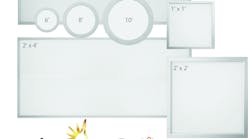The patent relates to LED-based lighting systems that are used to indicate the condition of an item. The intelligent lighting device can receive information signals and can change hue, saturation, and brightness as a result.
The patent claims embodiments where the item is a package or container and the illumination system indicates information about the condition of the package/container. Conditions could include age, elapsed time, exposure to temperatures or radiation, and many others.
Recent US patent applications dated May 25, 2005
For more information on these applications, paste the application number into the USPTO search page .
1. US patent application 20050110036
LED package
Disclosed is an LED package, which comprises a substrate, internal electrodes provided in an even (2n) number and formed on an upper surface of the substrate, external electrodes provided in the even (2n) number, formed on at least a part of surfaces of the substrate other than the upper surface of the substrate, and electrically connected to the corresponding internal electrodes, and LEDs provided in the even (2n) number, located on the upper surface of the substrate, and provided with an anode and a cathode, wherein the anodes and cathodes of the LEDs are electrically connected to the internal electrodes such that the anode of each of the LEDs is connected to the anode of a neighboring one of the LEDs and the cathode of each of the LEDs is connected to the cathode of another neighboring one of the LEDs.
2. US patent application 20050110649
LED aircraft anticollision beacon
An exemplary aircraft anticollision beacon is constructed around a faceted aluminum support cylinder and base. The support cylinder has an outside surface with ten vertically oriented substantially planar faces. An array of LEDs is mounted in thermally conductive relationship on each face of the support cylinder. Each LED is partially surrounded by a trough-shaped reflecting surface that re-directs off axis light into a horizontal plane. Axially aligned, radially adjacent reflecting troughs combine to form the circumferential reflecting troughs. The support cylinder and base are connected in thermally conductive relationship to define a thermal pathway from the LEDs to a heat radiation surface on the base. The base is also configured to act as a heat sink for heat generating components of the LED driver circuits. The exemplary beacon employs a distributed energizing circuit in which each driver is configured to energize two of the ten arrays of LEDs.
3. US patent application 20050111217
Color changing candle
A color-changing candle is provided. The color-changing candle includes a fiber optic strand running adjacent and substantially parallel to the wick of the candle and interfaces with a photosensor. Light from the burning wick is transmitted via the fiber optic strand to the photosensor. When the photosensor is activated, a control unit illuminates one or more LEDs to change the color of the candle.
4. US patent application 20050111220
Composite reflecting surface for linear LED array
A composite reflecting surface for a linear LED array incorporates a truncated circular parabolic reflector surrounding each LED and a trough axially above the circular parabolic reflectors defined between parallel longitudinal reflecting surfaces. The short circular parabolic reflectors collimate wide angle light from the LED into a direction parallel to the LED optical axis. The longitudinal reflecting surfaces are linear parabolic surfaces altered to improve the vertical spread of the light radiation pattern. Longitudinal convex ribs project inwardly from the basic linear parabolic shape. The convex shape of the ribs “sprays” the light incident upon it in a vertically spread pattern. The composite reflecting surface makes use of light from a linear array of LEDs that would otherwise be wasted.
5. US patent application 20050110035
Tri-color ZnSe white light emitting diode
A Tri-color ZnSe white light emitting diode includes at least a ZnSe LED chip, a blue emission layer, and a green fluorescent powder. Each of ZnSe LED chip is a white light source. The blue emission layer is formed on the ZnSe LED chip to emit blue wavelength light, which shines the ZnSe LED chip to produce yellow light. The green fluorescent powder is covered onto ZnSe LED chip capable of absorbing blue light emitted from the blue emission layer to emit green wavelength light, so that mixing the blue light, yellow light, and green light to produce the white light emitting diode.




